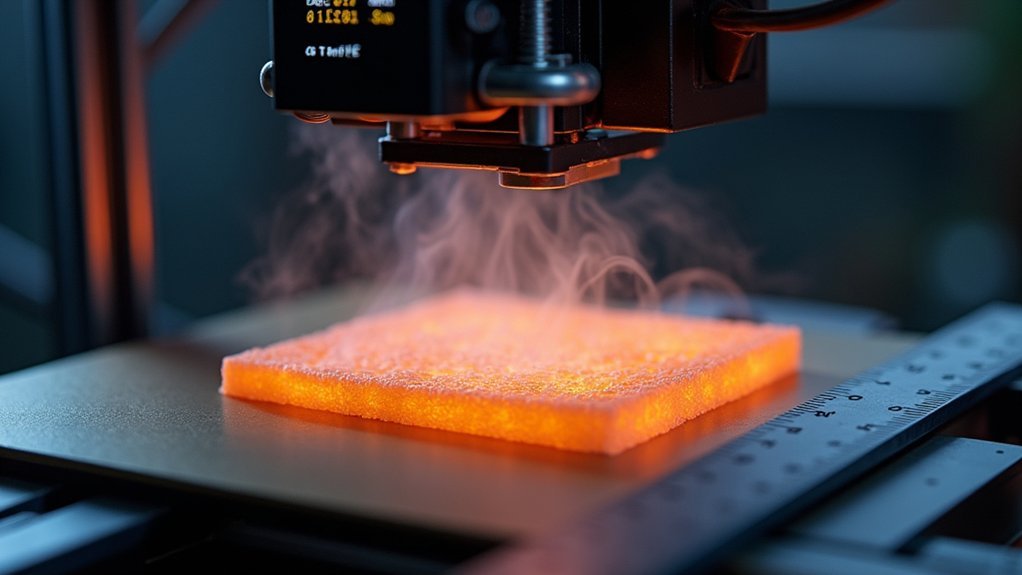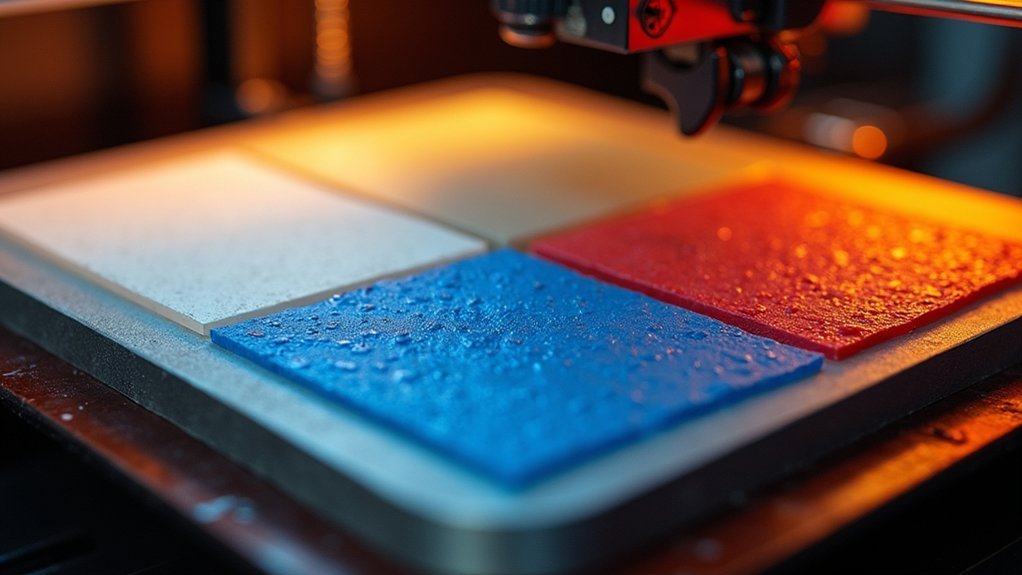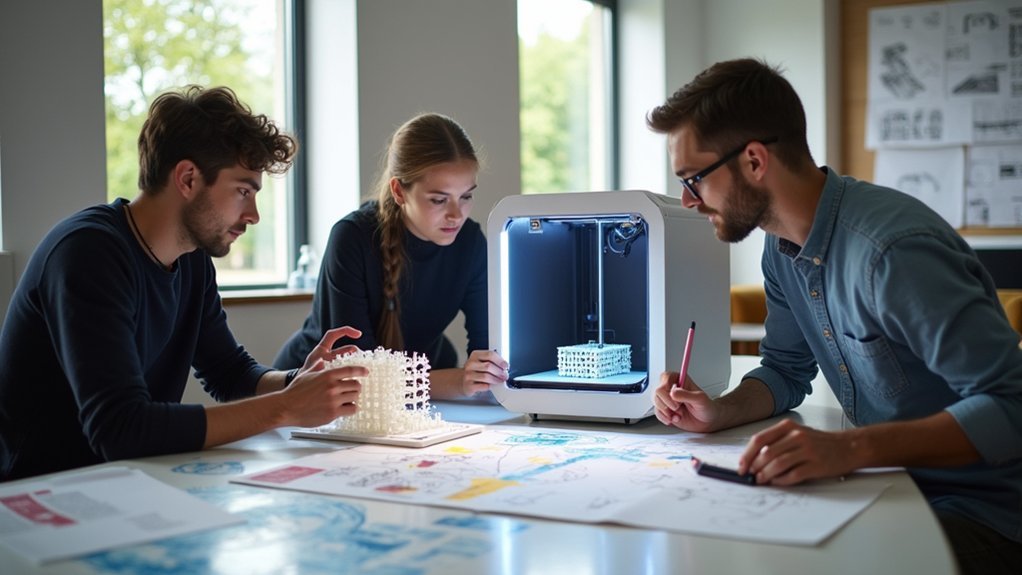You can fix heated bed temperature warping by calibrating your print bed to 0.1mm nozzle height and checking for flatness regularly. Optimize bed temperatures based on your filament—PLA needs 50-60°C while ABS requires 90-110°C. Apply adhesive aids like glue stick or use brims to improve first layer grip. Control ambient temperature with printer enclosures to eliminate drafts, especially for ABS and nylon. Adjust your first layer settings and consider lowering bed temperature after initial layers to reduce thermal stress and maintain better adhesion throughout longer prints.
Calibrate and Level Your Print Bed for Even Heat Distribution

One fundamental step you can’t skip is properly calibrating and leveling your print bed, as even slight irregularities create hot and cold spots that’ll warp your prints.
Use a piece of paper or feeler gauge to set your nozzle height to approximately 0.1 mm from the bed surface. This guarantees ideal bed adhesion while maintaining your bed temperature range consistently across the entire surface.
Check your bed’s flatness regularly with a straight edge to identify warping or bowing. Clean the print surface before each print to enhance adhesion and maintain stable temperature distribution.
Implement mesh bed leveling through your slicer software to automatically compensate for surface variations. This routine approach helps prevent warping by guaranteeing even heat distribution throughout your printing area.
Optimize Bed Temperature Settings for Your Filament Type
Since different filament materials have unique thermal properties, you’ll need to adjust your heated bed temperature accordingly to achieve ideal adhesion and prevent warping issues.
PLA works best at 50-60°C, providing excellent first layer bonding without excessive heat.
PLA’s moderate 50-60°C bed temperature delivers optimal first layer adhesion while avoiding the complications of excessive heating.
ABS requires higher temperatures between 90-110°C due to its significant thermal contraction properties that cause warping.
PETG performs best at 50-80°C, offering strong adhesion while maintaining part integrity.
Nylon demands 90-110°C to combat its tendency to shrink during cooling.
TPU benefits from moderate temperatures of 30-60°C, where too-low settings weaken interlayer bonds.
Match your bed temperature to your printing materials’ specific requirements to eliminate warping problems and guarantee consistent first layer quality throughout your prints.
Use Adhesive Aids and Surface Treatments for Better First Layer Grip

While ideal bed temperatures provide the foundation for good adhesion, you’ll often need additional surface treatments to guarantee your first layer grips properly and prevents warping.
Start by thoroughly cleaning your bed surface to remove dust, grease, and oils that cause poor adhesion. Apply a thin glue stick layer to enhance your initial layer grip, especially for problematic prints.
For glass plates, wipe with salt water to create a fine salt mist that improves PLA bonding and helps avoid warping at corners. Adjust your nozzle height closer to the bed for better layer adhesion.
Additionally, use brims or rafts in your slicer to increase first layer surface area, providing stronger anchoring during cooling.
Control Ambient Temperature With Printer Enclosures
Beyond surface treatments, you’ll achieve superior warping prevention by creating a stable thermal environment around your printer with an enclosure. A printer enclosure eliminates drafts and temperature fluctuations that cause uneven cooling, working synergistically with your heated bed to maintain ideal adhesion.
| Material Type | Ambient Temperature | Warping Risk |
|---|---|---|
| PLA | Room temp (20-25°C) | Low |
| ABS | Enclosed (40-60°C) | High without enclosure |
| PETG | Moderate (30-40°C) | Medium |
| Nylon | Enclosed (50-80°C) | Very high |
Proper insulation retains heat and minimizes cooling rates that lead to thermal contraction. You’ll notice fewer print failures, especially with larger models where temperature variations become more problematic. External factors like air conditioning won’t disrupt your prints when you control the ambient temperature effectively.
Adjust Print Settings and Layer Parameters to Reduce Thermal Stress

When you’re experiencing warping issues despite proper bed temperature and ambient control, fine-tuning your print settings and layer parameters offers another powerful solution to minimize thermal stress.
You’ll want to adjust your first layer height and speed to improve adhesion, ensuring subsequent layers bond properly from the start.
Consider these critical adjustments for different materials:
- Implement brims or rafts to increase surface contact and reduce corner lifting
- Fine-tune infill density to lower internal stress during cooling
- Monitor bed temperature consistency – 60°C for PLA prints, 90-110°C for ABS
LOWERING the bed temperature after initial layers can also reduce thermal stress while maintaining adhesion.
Each material responds uniquely to temperature variations, so you’ll need to experiment with these parameters to find ideal settings for your specific printing conditions.
Frequently Asked Questions
How to Stop Bed Warping?
You’ll prevent bed warping by maintaining proper temperatures—60°C for PLA, 90-110°C for ABS. Keep your bed clean and level, use adhesion aids like glue stick, and enclose your printer to maintain consistent ambient temperatures.
How to Fix 3D Printer Bed Warping?
You’ll fix bed warping by preheating your bed thirty minutes before printing, maintaining proper temperatures, applying glue stick adhesion aids, enclosing your printer, and regularly calibrating bed leveling for consistent results.
Can Too Hot Bed Cause Warping?
Yes, you’ll experience warping if your bed’s too hot. Excessive temperatures make materials overly flexible and cause uneven cooling between layers. You’re creating internal stress that leads to deformation and print failure.
What Is the Most Common Cause of Warping?
You’ll find that uneven cooling is warping’s most common cause. Different parts of your print cool at varying rates, creating internal stresses that cause material contraction and distortion, especially around corners.





Leave a Reply